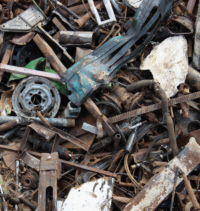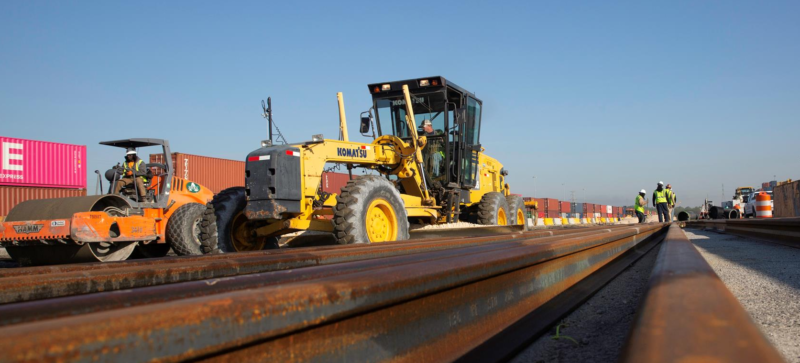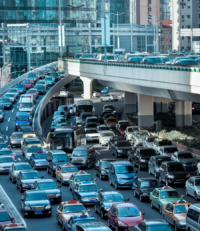In collaboration with industry experts and researchers, OnTrackNorthAmerica is leading the development of a comprehensive dataset of land freight lifecycle impacts. Lasting negative impacts as well as costly delays during project development can be avoided if this wider set of factors, and stakeholder interests, are considered in plans and investments.
Infrastructure investments must reflect a complete understanding of the comparative impacts of trucks and railroads.
 Labor Costs to build the project
Labor Costs to build the project
Materials Costs not including land acquisition
Materials Lifecycle Impacts of sourcing and transporting construction materials
Contractor Costs including entities or companies that plan, engineer, finance, and build new infrastructure which may include the labor and materials
Equipment Costs to build the project including the energy to operate
Energy, including sourcing and distribution, used to transport goods
Labor and Administration cost for providing the required transportation service
Maintenance of Transportation Assets required to keep freight transportation viable and safe
Useful Life of the Transportation Asset Estimated life of the road surface, foundation, bridges, and track
Transport Equipment acquisition including trucks, locomotives, containers, rail cars, etc., considered over useful life
Maintenance of Transport Equipment required to keep freight transportation equipment viable and safe
End of Life Equipment Disposition Value and Impact of equipment disposition at end of life
Freight Mobility and Connectivity is the impact of time for moving goods from origination to destination
Criteria Pollutants from fuel emissions that cause smog, acid rain, and other health hazards
Greenhouse Gas emissions from the construction, operation, and maintenance of transport infrastructure that contribute to global warming
Noise impact on quality of life for areas abutting infrastructure from engines, rolling stock, and aerodynamics
Water Quality impact of vehicle and fuel contamination on adjacent and downstream wildlife and natural environment
Light Pollution impact from transportation on a community or on wildlife and the natural environment
Toxic releases including accidental and non-accidental releases of transported hazardous materials.
Wildlife Vitality including life expectancy and health impact on animals from truck and rail movements

Land Used for Transport needed by each mode for moving ton-miles of freight, including right-of-way and parking
 Safety including fatalities and injuries per ton-mile of freight
Safety including fatalities and injuries per ton-mile of freight
Safety to the Transportation Providers including on-the-job fatalities and injuries
Travel Congestion – Recurring impacts on highway capacity, lost time, and impacts of additional fuel use from truck and railroad operations
Travel Congestion – Nonrecurring impacts on highway capacity, lost time, and impacts of additional fuel use from truck and railroad crashes
Peaceful Enjoyment impact on use of land adjacent to road and rail transportation corridors
Property Tax Impact due to presence of transport infrastructure
Impact of Transportation Infrastructure on adjacent property values
Land Freight Lifecycle Impact Project Action Steps:
- Gathering: Taking full inventory of existing data.
- Assessment: Convene representatives from all freight transportation perspectives to gauge the timeliness and value of each factor-set.
- Commission: Gather funding and then commission the needed research.
- Dissemination: Make data available for low cost to the nation’s infrastructure planners, including campaign to promote awareness of new data.
Project Leader
Chairman, OnTrackNorthAmerica
Project Advisors
Director, Institute for a Secure and Sustainable Environment
University of Tennessee
As our Project Advisor Dr. Jin relates in his support letter, there is a yawning gap between the volumes of thoughtful research and its pragmatic application in the field. This project bridges that gap. It provides the framework for applying the fine work of researchers that study the individual elements of transportation costs and impacts.
Research and data alone are not enough… More than new research, this project will empower policymakers, citizens, and businesses with the full lifecycle implications of truck and rail transportation investments. Armed with that knowledge, we can consciously choose a new future. You are invited to contribute.
Project Outline
PHASE 1: Convening and Consensus
- Prepare a draft list of costs and impacts to seed the large group engagement [complete]
- Prepare and submit project grant proposals for foundation funding
- Convene stakeholders in facilitated process to complete and agree on a comprehensive list of cost and impact metrics
PHASE 2: Data Assessment
- Develop and document methods of calculating agreed metrics
- Identify data required for the calculation methods
- Investigate available data sources
- Pinpoint the metrics where data is missing or not maintained
- Determine proxy measures for approximating missing data in lieu of primary research
- Determine the data that is ongoingly tracked by others versus the data that will need to be measured by us or others in future years
PHASE 3: DataSet Building
- OTNA or affiliated entities conduct primary research for those metrics data that have not been pinpointed and can not be approximated effectively
- Establish resources and methods for data formatting, alignment, and housing of data from the variety of providers
- Establish the relations and the process for collaborating entities to provide their data ongoingly into our dataset
- Establish resources and methods for data publication and dissemination
- Develop the guidance on how to evaluate and analyze transportation systems with the developed metrics and dataset
- Build in-house capability or a collaborative relationship for building the data and systems analysis tool/software application
- Convening and Consensus
-
PHASE 1: Convening and Consensus
- Prepare a draft list of costs and impacts to seed the large group engagement [complete]
- Prepare and submit project grant proposals for foundation funding
- Convene stakeholders in facilitated process to complete and agree on a comprehensive list of cost and impact metrics
- Data Assessment
-
PHASE 2: Data Assessment
- Develop and document methods of calculating agreed metrics
- Identify data required for the calculation methods
- Investigate available data sources
- Pinpoint the metrics where data is missing or not maintained
- Determine proxy measures for approximating missing data in lieu of primary research
- Determine the data that is ongoingly tracked by others versus the data that will need to be measured by us or others in future years
- DataSet Building
-
PHASE 3: DataSet Building
- OTNA or affiliated entities conduct primary research for those metrics data that have not been pinpointed and can not be approximated effectively
- Establish resources and methods for data formatting, alignment, and housing of data from the variety of providers
- Establish the relations and the process for collaborating entities to provide their data ongoingly into our dataset
- Establish resources and methods for data publication and dissemination
- Develop the guidance on how to evaluate and analyze transportation systems with the developed metrics and dataset
- Build in-house capability or a collaborative relationship for building the data and systems analysis tool/software application
Relevant Papers by Dr. Mingzhou Jin, Project Advisor
Wang and M. Jin, “Transportation Performance Measurement System with a Case Study in Mississippi,” The Journal of the Transportation Research Forum, 45 (3), pp. 19-37, 2006. You can find the full text at https://collaboration.fhwa.dot.gov/dot/fhwa/pm/Lists/aReferences/DispForm.aspx?ID=79 or http://journals.oregondigital.org/trforum/article/view/606/511
P. Kelle and M. Jin, “Development of Performance Measurement for Freight Transportation,” Final Report 522, NCITEC and Louisiana Department of Transportation and Development, 2014. You can access it at https://www.ltrc.lsu.edu/pdf/2014/fr_522.pdf


